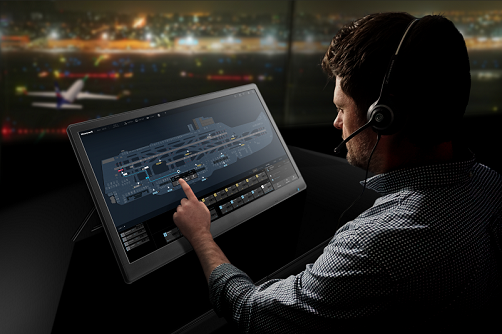Honeywell has recently announced new smart airport technology that helps enhance the safety and efficiency of airside operations. The Honeywell NAVITAS™ software suite intelligently integrates air and ground traffic control with maintenance operations so airports can more easily accommodate growing air traffic while promoting safety and on-time performance.
Developed to comply with the latest industry standards set forth by organizations – including the International Civil Aviation Organization (ICAO), European Aviation Safety Agency (EASA), International Electrotechnical Commission (IEC), Federal Aviation Administration (FAA) and European Organisation for Civil Aviation Equipment (EUROCAE) – Honeywell NAVITAS includes modular and scalable software components, combined with an intuitive userfriendly interface, providing real-time insights for air traffic controllers and maintenance operators. The components assist personnel in visualizing and routing aircraft movements – from enhancing situational awareness about traffic conditions and more safely expediting aircraft turnaround times, to automating fault diagnostics for airside equipment – all despite the increasing complexity and stress associated with today’s airport operations.

“Airports around the globe are seeing dramatic increases in traffic, and while that makes the world more connected, it increases complexity to ensure safe and reliable operations,” said Sonja Strand, Vice President and General Manager for Honeywell’s Global Airports Business, “NAVITAS helps orchestrate these complex environments like never before through mobile applications, dashboards and heads-up displays that are intuitive. By harnessing the power of the Internet of Things, we’re making data user friendly, and making airports smarter in the process.”
The Honeywell NAVITAS modules include:
- Honeywell NAVITAS Tower Manager helps improve the productivity of air traffic controllers by enhancing situational awareness of airport surface operations. It gives controllers access to rich, real-time information on ground, air traffic and meteorological conditions, presenting the information in a single, easy-touse interface, and providing visibility into a multitude of traffic events while reducing the chance for error. The system helps manage the air traffic controller’s responsibilities, while making it easier to issue and track aircraft clearance information to keep landings and takeoffs safer and on time.
- Honeywell NAVITAS Surface Manager helps airports get more out of their existing infrastructure by enhancing ground traffic safety, fluency and throughput in a wide range of weather conditions, while helping New Roadmap Charts Path to Reduced Fire Hazards from Materials NIST firefighters Justin Grossnickle and Martin Neal look over the end of a controlled test to study the impact of fire on cross-laminated timber buildings. CLT is a construction material identified in a new NIST report as needing more flammability research. Fire researchers tell that there’s a simple solution for reducing fire hazards and that is to eliminate flammable materials. If it doesn’t burn, the experts say, then there won’t be a fire. Of course, that option isn’t very practical or realistic; after all, who wants to sit on a block of cement when one can have a cushiony recliner? A better strategy for reducing the thousands of deaths and injuries and billions of
 dollars in damage resulting from the more than a million fires each year in the United States is detailed in a new research roadmap published by the National Institute of Standards and Technology (NIST). The roadmap provides guidelines for developing science-based approaches to solving numerous fire problems for multiple materials, from lightweight automobile composites to cross-laminated timbers, and prioritizes the most critical and urgent fire hazards to which they can be applied such as upholstered furniture. “Our hope is that this roadmap will help the global fire community develop research strategies and implementation plans for addressing fire and materials to reduce their fuel burn and carbon footprint. The module also provides the software necessary for airports to use all four levels of an AdvancedSurface Movement Guidance and Control System (A-SMGCS), including surveillance, routing, guidance and airport safety support, along with enhanced movement conflict detection and resolution, which can include ‘follow-the-greens’ based guidance that automatically illuminates lighting on the tarmac to guide aircraft to clear taxiways.
dollars in damage resulting from the more than a million fires each year in the United States is detailed in a new research roadmap published by the National Institute of Standards and Technology (NIST). The roadmap provides guidelines for developing science-based approaches to solving numerous fire problems for multiple materials, from lightweight automobile composites to cross-laminated timbers, and prioritizes the most critical and urgent fire hazards to which they can be applied such as upholstered furniture. “Our hope is that this roadmap will help the global fire community develop research strategies and implementation plans for addressing fire and materials to reduce their fuel burn and carbon footprint. The module also provides the software necessary for airports to use all four levels of an AdvancedSurface Movement Guidance and Control System (A-SMGCS), including surveillance, routing, guidance and airport safety support, along with enhanced movement conflict detection and resolution, which can include ‘follow-the-greens’ based guidance that automatically illuminates lighting on the tarmac to guide aircraft to clear taxiways.
- Honeywell NAVITAS Engineering Manager helps engineers and technicians manage maintenance by enabling them to more effectively monitor system health, more easily perform fault diagnostics and to streamline workflows, which also often helps reduce operational costs. It features a mobile interface and automates the diagnostics and failure reporting, while simplifying manual tasks and reducing paperwork, giving personnel better visibility into the availability, reliability and performance of airside systems. Personnel can easily create, manage and issue work orders to expeditiously resolve issues and keep equipment up and running.
- Honeywell NAVITAS Performance Manager features dashboards that allow airport staff to collaborate and analyze operations in line with key performance indicators. The module which is accessible both on premise and remotely provides access to a common base of holistic information and allows for the application of big data analytics for real-time and predictive insights, often enabling more efficient and informed decisionmaking.